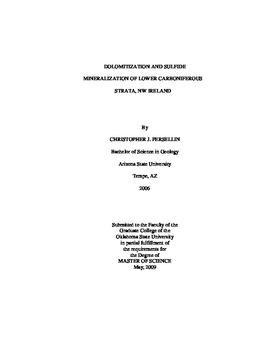| dc.contributor.advisor | Gregg, Jay M. | |
| dc.contributor.author | Persellin, Christopher J. | |
| dc.date.accessioned | 2014-03-14T21:52:05Z | |
| dc.date.available | 2014-03-14T21:52:05Z | |
| dc.date.issued | 2009-05-01 | |
| dc.identifier.uri | https://hdl.handle.net/11244/8046 | |
| dc.description.abstract | The Pb-Zn sulfide mineralization at Abbeytown Mine and Twigspark Quarry comprise the only known carbonate-hosted base-metal sulfide deposits in the Sligo Syncline, northwest Ireland. Prior studies at Abbeytown Mine have suggested that mineralizing fluids were derived regionally and were present throughout the Sligo Syncline. This study examined mineralization at Abbeytown, Twigspark and two additional locations in northwest Ireland to determine the origins and regional extent of mineralizing fluids. An emphasis was placed on establishing geographic and stratigraphic relationships to determine if and to what extent regional fluid migration was present during diagenesis. Host limestone sedimentation occurred concurrently throughout the region as indicated by field relationships and petrography; however petrographic and stable isotope evidence indicates host rock dolomitization occurred under differing conditions at localities to the west of the Ox Mountains Inlier and localities to the east of the Inlier, suggesting significant uplift and geologic isolation of these areas prior to dolomitization. Localized fluid flow systems are responsible for sulfide mineralization and associated epigenetic carbonate cements. West of the Ox Mountains Inlier at Abbeytown three geochemically distinct fluids are observed: 1) a lower-temperature, lower-salinity fluid (70-130 �C, 4-9 wt. % equiv. NaCl); 2) a lower-temperature, higher-salinity fluid (70-140 �C, 15-24 wt. % equiv. NaCl); and 3) a higher-temperature, moderate-salinity fluid (165-220 �C, 8-14 wt. % equiv. NaCl). Three similar fluid types were observed at nearby Twigspark Quarry. The source of the high-salinity fluid is likely seawater evaporated to near the point of halite precipitation. The higher-temperature fluid is thought to be derived from deep circulation of basinal brines. It is speculated that the interaction of the higher-salinity fluid with the higher-temperature fluid was vital for ore formation. Less complex fluid flow systems are indicated for sites east of the Ox Mountains Inlier where no sulfide mineralization was observed. | |
| dc.format | application/pdf | |
| dc.language | en_US | |
| dc.publisher | Oklahoma State University | |
| dc.rights | Copyright is held by the author who has granted the Oklahoma State University Library the non-exclusive right to share this material in its institutional repository. Contact Digital Library Services at lib-dls@okstate.edu or 405-744-9161 for the permission policy on the use, reproduction or distribution of this material. | |
| dc.title | Dolomitization and Sulfide Mineralization of Lower Carboniferous Strata, NW Ireland | |
| dc.type | text | |
| dc.contributor.committeeMember | Atewkana, Eliot | |
| dc.contributor.committeeMember | Puckette, James | |
| dc.contributor.committeeMember | Somerville, Ian | |
| osu.filename | Persellin_okstate_0664M_10178.pdf | |
| osu.college | Arts and Sciences | |
| osu.accesstype | Open Access | |
| dc.description.department | Boone Pickens School of Geology | |
| dc.type.genre | Thesis | |
| dc.subject.keywords | abbeytown | |
| dc.subject.keywords | dolomitization | |
| dc.subject.keywords | fluid inclusions | |
| dc.subject.keywords | ireland | |
| dc.subject.keywords | sulfide mineralization | |
| dc.subject.keywords | twigspark | |
